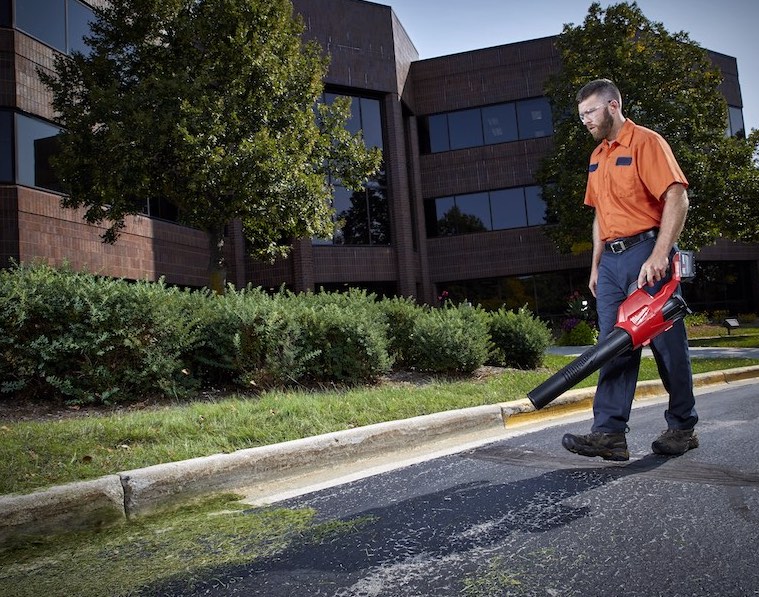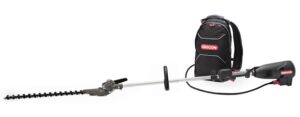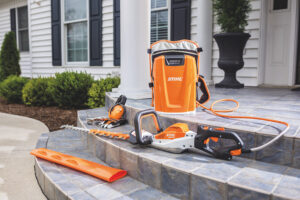Examining the growth of the battery-powered OPE market

Editor’s note:The following is excerpted from an article that originally appeared in the February issue of Outdoor Power Equipment magazine, sister publication to Landscape Business.
By John Kmitta
During the past several years, the outdoor power equipment (OPE) industry has seen a dramatic surge in the amount of battery-powered OPE in the market. Industry experts agree that battery-powered OPE is one of the hottest “trends” in the industry, and that trend does not appear to be slowing down anytime soon. Not only has the battery-powered handheld equipment market taken off, but battery-powered ride-on equipment – including ride-on and stand-on zero-turn mowers – is now available with commercial-quality runtime.
What has driven this technological shift? Where will advancements in battery power take us next? And what does it all mean for the future of the OPE industry?
Charging ahead
According to Josh Huffman, business segment director, outdoor power equipment, Oregon, a Blount International brand, a big reason for the rise of battery-powered OPE is the continued growth of the capacity-to-current ratio curve of lithium-ion cells.

“More available current (amps or power) with higher capacity (amp hours or runtime) cells results in a tool that is more likely to please the customer,” said Huffman. “It’s one thing when you’re talking about a 18V drill – we reached that power/capacity point years ago – but now, when you’re talking about a lawnmower or a chain saw, you’re talking about serious power needs and a customer demand for long runtimes.
Huffman added that as the electric automobile market pushes the envelope on power systems, battery capacity, production, new technologies and technical advancements, the OPE market benefits.
Chris Urlaub, associate marketing manager, portable power at Toro, added that advancements in lithium-ion battery technology have helped alleviate consumers’ concerns that battery-powered products will have enough power and runtime for their needs.
“This combination of more power, more runtime, and consumers’ increasing desire for a convenient alternative to gas has resulted in a dramatic increase in battery-powered outdoor power equipment over the last several years,” said Urlaub.
According to Tony Marchese, director of independent retail for Greenworks North America, another reason for the rise of battery-powered equipment is that municipalities are driving the need for landscapers to purchase battery-powered products. “There are now more than 500 cities with some sort of ban of 2-stroke or 4-stroke engines,” said Marchese. He added that the market is also being driven by the desire of corporate America to go “green” with companies such as Coca-Cola, Google and Apple demanding that their landscapers use “green” or rechargeable products to maintain their corporate landscapes.
Christian Johnsson, North American product manager for handheld products at Husqvarna, said that, as a global company, Husqvarna has seen a far greater demand for battery-powered outdoor power equipment in Europe, because the price of gasoline is higher in Europe, and because municipalities, cities and countries are banning gas-powered products to cut down on noise pollution and emissions. Similar bans in California and in some northeastern states are beginning to drive users to battery-powered equipment in the U.S.
Johnsson said there are landscapers and arborists who have become early adopters of battery-powered equipment, and have been willing to shift to battery. As a result, they have leverage over competitors in their area who aren’t using battery because they can start earlier, work later, and work closer to schools and hospitals due to the reduced noise. Contractors using battery-powered equipment can also promote the fact that they are cutting down on noise pollution and emissions, and, as a result, position their businesses as environmentally friendly, and, in turn, charge more for their services.
Marchese added that, on the consumer side, Loews, Home Depot and Amazon are driving their customers to battery-powered outdoor power equipment, because it cuts down on the number of product returns.
Advancements in battery technology

“Battery technology has advanced, and continues to advance to the level where tools can perform on the level of certain gas tools,” said Mike Poluka, handheld battery equipment product manager at Stihl Inc. “Batteries continue to increase in capacity, and the benefit there is longer runtime – sometimes with little to no weight increase.”
According to Andrew Lentz, group product manager, Milwaukee Tool, similar to how the power tool industry saw battery equipment catch up to corded power tools, advancements in overall system architecture have helped drive the rise of battery-powered OPE.
“Over the last 10 years, just from a battery perspective, we have batteries delivering four to five times more capacity than 8 to 10 years ago,” Lentz added. “That has come a tremendously long way.”
“When we started developing commercial electric mowers almost 10 years ago, the best battery source was lead acid batteries,” said Joe Conrad, president of Mean Green Mowers. “Lead acid batteries made our mowers very heavy and would still only last a few hours before needing to recharged or swapped out.”
According to Conrad, lithium batteries have allowed much better runtime and much less weight than lead acid technology.
“With the greater acceptance of electric cars over the past few years, more lithium battery manufacturers have greatly increased automation, and applied new chemistry to their production lines,” said Conrad. “Ten years ago, our 720-pound lead acid battery pack would run about two hours on our 60-inch ZTR mower. Today, our 340-pound Green Lithium battery pack will give us up to seven hours of continuous runtime.”
Conrad added that the biggest factor currently limiting acceptance of battery-powered mowers on the part professional landscapers is the initial cost of electric mowers compared to traditional. “As the prices of traditional mowers keep sharply rising due to air pollution regulations, and the price of new battery technologies continue to decrease, more and more contractors will realize the benefits sooner, and begin to switch to all electric,” he said.
According to Graeme Harfman, director of product management at Delta-Q, a manufacturer of industrial battery chargers for lead acid and lithium-ion batteries, lithium battery technology is built on a foundation of cells, and a number of cells are built up to a pack. A battery management system (BMS) controls and manages the charge and discharge from that pack.
“As the cost of the lithium packs drops down, the market will adopt these, because it will reach a price that is nearer the internal combustion engine units, and the closer you get, the more it is going to adopt,” Harfman added.
According to Harfman, runtime versus cost is going to be an important metric for OEMs to follow. Monitoring how cost reduction factors in will determine a point in time when this technology will really take off.
“We can give the user the equivalent to running gas,” said Marchese. “But a 5-amp-hour battery is heavier than we would like. We have new technology, new cells coming that will reduce that weight. We will see 6 or 7 amp hours in same platform because of the reduced weight of the cells. We will see change in the next 12 to 24 months in terms of weight reduction.”
“As other markets adopt more lithium technology, the cost is going to decrease and the features are going to improve,” said Harfman. “There are a lot of innovations helping there, and bringing the price down.”
Where do we go from here?
“If there is any doubt in someone’s mind that the battery industry is a fad, or the growth will slow down soon, they are simply mistaken,” said Huffman. “Eventually, we won’t see year-over-year double-digit growth like we are now – simply because the math will run out – but the growth will continue. In the not too distant future, battery will outpace gas in annual sales in most of our categories. We already see this with certain market groups and industry associations reporting more battery sales than gas in some big categories.”

Johnsson said that battery products, in general, have become much more advanced. He added that there is much more advancement to be made with regard to motors – brushless vs. brush. “It doesn’t always make sense to do everything brushless. Hedge trimmers, for example, need more torque, so maybe brush is better,” he added.
Huffman cautions that projections of technological advancements that will quadruple runtimes or charge batteries “in 5 seconds” are farfetched. “I’ll never say never, but most of those won’t become marketable products, and the ones that will are decades away from being so,” he added. “However, we should expect continued growth in capacity and power output, but at more reasonable rates.”
Johnsson said that the challenge with developing battery-powered equipment is to ensure that the equipment delivers professional-grade performance. “It’s hard to replace everything we have as gas with battery.” He pointed out that large chain saws and backpack blowers require a lot of power that would be difficult to do with battery. “It’s going to take the industry some time to figure that. We’re working on so many levels developing product and creating a vision of where we think we will be in 5 to 10 years, and where we will be as a group (gas, battery and robotics).”
According to Lentz, lithium-ion technology will continue to expand in terms of output and capacity during the next five to 10 years. He added that growth will be somewhat linear, but the focus will be on reducing charge times.
A competitive market
The shifts in the battery-powered outdoor power market have not just been shifts in the battery technology and the equipment itself. During the past few years, the OPE industry has seen a shift in battery-powered equipment manufacturers as well. Several manufacturers that were not traditional to the OPE market have introduced battery-powered OPE in recent years because they had an established foundation in battery technology in the power tool market (i.e., drills, saws, etc.). As power tool manufacturers have worked to introduce battery-powered OPE and adapt to the needs of OPE end users, traditional OPE manufacturers have had to adapt to battery technology.
“A rising tide lifts all boats,” said Huffman. “It’s great for the battery OPE industry as a whole when you see some of these traditional tool manufacturers getting into the OPE space, creating general awareness for battery-powered OPE. From a purely industrywide perspective, it’s done wonders to the awareness and growth of this category. That being said, not every tool is made equally.”
According to Johnsson, the traditional power tool companies that have entered the battery-powered OPE market have have done a lot of great things over the years, and he added that competition sharpens everybody. But he added that Husqvarna has nearly 330 years as a manufacturer and has been producing outdoor power equipment for close to 70 years. “We know how to create a product with the purposeful design the user needs,” said Johnsson. “Our advantage in this market is that we have the knowhow of the end user.”
According to Huffman, some players have done a great job introducing good-quality, good-value products, where others have fallen short.
“Good ones – and there are some really good ones – have put the industry on notice. They see this space as an opportunity for growth, and believe they can win here,” said Huffman. “It’s up to each individual company to decide how to respond – make better products, improving value to the customer, or get pushed aside by hungry, talented companies who may be new to the category, but are clearly here to stay.”
Marchese said the influx of companies offering battery-powered OPE has made a vast difference in the competitive landscape.
“Several companies, including ours, have come into the market offering wider lines,” said Marchese. “Companies that were not known five years ago are now becoming leaders. When you have a change in technology, industry leaders are not always the ones that win the war. We are cementing ourselves as the leader.”
Poluka said that Stihl’s focus has always been on outdoor power equipment.
“Our history has always been outdoor power equipment, and that is our main focus,” said Poluka. “That allows us to produce battery-powered landscape tools to the quality of gasoline powered.”
Lentz added that the level of competition is great for the industry, and it’s exciting to see all the players who are invested in the space.
“Companies like ours have been focused on cordless technology for a long time,” he said. “We don’t focus resources on internal combustion engines. This user was new to us. The great thing is that we are resourced to learn about that user and their behaviors, and get up to speed in a relatively quick timeframe. The traditional companies knew the user, but to get up to speed on cordless technology is far more challenging. That’s why you have seen traditional power tool companies leverage that knowledge and get product to market pretty quickly.”
Lentz added that the number of manufacturers adopting battery technology is great for the market and the end user, because it will lead to a safer user experience, better operator communication, less noise and fewer emissions. “It’s a huge benefit,” he said. “It’s an exciting time to see everyone investing.”
“Non-traditional outdoor power equipment manufacturers entering the OPE market have put pressure on companies like Toro to continue to innovate and differentiate,” said Urlaub. “Ultimately, consumers will benefit from increased competition by taking advantage of the innovation that naturally follows.”
John Kmitta is associate publisher/editor of Outdoor Power Equipment magazine and the Landscape Business digital properties.
For the full article, visit https://outdoorpowerequipment.com/2019/02/20/taking-charge/12879/


